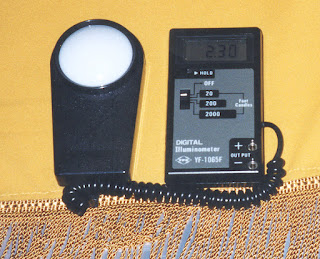Prior to being placed in the care of the Maine State Museum in 2000, about half of the flags hung in the "Hall of Flags" (the ceremonial heart of Maine's government) in the rotunda of the State House. Understandably, these flags suffered the most damage. They were at times arrayed in the open, handled extensively, cut into by souvenir seekers and they were stretched and tacked into place in cabinets. By the 1960's several flags were in tatters. By the time an assessment was performed in 1993, not only were the conditions of the flags identified as a high conservation priority, but also the environmental conditions in which they were housed. In the Hall of Flags, the flags were exposed to light levels ranging from 33 to 166 fcs (foot candles) and the environmental conditions were identified as widely fluctuating.
 |
| Hall of Flags ca. 1872. Note the careful arrangement of the flags in the case. This design involved tacking the flags to the wall and cutting off the staffs so the flag would fit the case. |
Yet even with the imminent deterioration of the flags upon them, state legislators remained determined to keep the flags in the State House. At the head of this issue was the ability of the public to access the flags. For many Maine residents, the historic flags represented their connection to ancestors and the brave men and women who fought in various conflicts from 1820 to 1990. Consensus was found in 2000 with a simple solution: replace the flags in the Hall of Flags with replicas, while cleaning, stabilizing and housing the originals. Through this method, the public gained greater access to their flags than ever before through long term exhibition at the Museum, as well as a full catalog of images and background information always available on the Museum's website.
 |
| Flag storage allowing flags to remain flat. |
Changes in the location of the flags meant changes for the Museum. It now had custody of the 340 flags and was to treat, and store, or ready them for exhibit in an already incredibly limited space. Revolutionary thinking had to occur. And it was from this out of the box approach that the idea of a hybrid display case came to life. The case would be housed in the exhibit space of the museum, and would simultaneously act as the storage space for additional flags to be rotated into the exhibit at an interval of every six months. Revolutionary to the approach was also that the display cases were built for the size of the flags, not the space of the floor (previously some flags had to be folded to be stored). Museum staff designed these hybrid cases with incorporated storage units hidden behind cloth covered panels, housed below the flag exhibit case.
 |
| Large double capacity flag case for exhibit and storage. Hidden storage for mounted flags that are ready to be rotated into exhibit is behind the cloth-covered front panels. |
The case also houses a datalogger for humidity monitoring as well as fiber optic lighting which have allowed museum staff to keep light levels at or below 2.5 fcs. In addition, case lighting is tied to motion sensors, further limiting the amount of light which each flag is exposed to.
 |
| Light meter. Replica flags were used for lighting adjustments. |
Because the flags were stabilized in-house, and the panels were designed to go from storage to display, the costs to stabilize the flags was only 25 - 33% of what it was originally estimated. Unfortunately, funding and practicality do not allow for each flag in the Museum's collection to be mounted (for example, the 85 foot pennant from a ship). Yet each of Maine's flag's are stabilized and available to the public, via internet catalog, exhibit or replica, thus achieving the Museum's goals.
As a conservator, employing practicality in a project is rewarding. The needs of this particular space clearly dictated the way the objects needed to be stored and demanded that the conservation team needed to approach this project in a way that challenged us all. While the end result seems like such a simple and logical approach it also seems so underutilized, perhaps because we fall into the habit of doing things the way they have been done simply because they have been done that way for so long.
To read more about The Maine State Museum's exhibit visit here: http://collections.mainestatemuseum.com/collection/results.do;jsessionid=40236684A78BDFE062309B27AF7277E0?highlight=38
This post by Barbara Owens is a summary of a talk and paper by Gwen Spicer, "Saving Maine's Colors: Collaborative Strategies in Flag Conservation and Exhibition at the Maine State Museum" at Tales in the Textiles: The Conservation of Flags and Other Symbolic Textiles .
_____________________________
Gwen Spicer is a textile conservator in private practice. Spicer Art Conservation specializes in textile conservation, object conservation, and the conservation of works on paper. Gwen's innovative treatment and mounting of flags and textiles is unrivaled. To contact her, please visit her website.

No comments:
Post a Comment